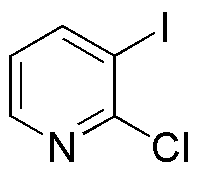2-Chloro-3-iodopyridine is widely utilized in research focused on:
- Synthesis of Pharmaceuticals: This compound serves as an important intermediate in the production of various pharmaceuticals, particularly those targeting neurological disorders and cancer treatments.
- Agrochemical Development: It is used in the formulation of agrochemicals, contributing to the development of effective pesticides and herbicides that enhance crop protection.
- Material Science: The compound is applied in the creation of novel materials, including conductive polymers and organic electronics, which are essential in the advancement of technology.
- Biochemical Research: Researchers utilize it in the study of biochemical pathways and mechanisms, aiding in the discovery of new biological targets for drug development.
- Fluorescent Probes: 2-Chloro-3-iodopyridine is also employed in the design of fluorescent probes for imaging applications, allowing for better visualization in cellular studies.
General Information
Properties
Safety and Regulations
Applications
2-Chloro-3-iodopyridine is widely utilized in research focused on:
- Synthesis of Pharmaceuticals: This compound serves as an important intermediate in the production of various pharmaceuticals, particularly those targeting neurological disorders and cancer treatments.
- Agrochemical Development: It is used in the formulation of agrochemicals, contributing to the development of effective pesticides and herbicides that enhance crop protection.
- Material Science: The compound is applied in the creation of novel materials, including conductive polymers and organic electronics, which are essential in the advancement of technology.
- Biochemical Research: Researchers utilize it in the study of biochemical pathways and mechanisms, aiding in the discovery of new biological targets for drug development.
- Fluorescent Probes: 2-Chloro-3-iodopyridine is also employed in the design of fluorescent probes for imaging applications, allowing for better visualization in cellular studies.
Documents
Safety Data Sheets (SDS)
The SDS provides comprehensive safety information on handling, storage, and disposal of the product.
Product Specification (PS)
The PS provides a comprehensive breakdown of the product’s properties, including chemical composition, physical state, purity, and storage requirements. It also details acceptable quality ranges and the product's intended applications.
Certificates of Analysis (COA)
Search for Certificates of Analysis (COA) by entering the products Lot Number. Lot and Batch Numbers can be found on a product’s label following the words ‘Lot’ or ‘Batch’.
*Catalog Number
*Lot Number
Certificates Of Origin (COO)
This COO confirms the country where the product was manufactured, and also details the materials and components used in it and whether it is derived from natural, synthetic, or other specific sources. This certificate may be required for customs, trade, and regulatory compliance.
*Catalog Number
*Lot Number
Safety Data Sheets (SDS)
The SDS provides comprehensive safety information on handling, storage, and disposal of the product.
DownloadProduct Specification (PS)
The PS provides a comprehensive breakdown of the product’s properties, including chemical composition, physical state, purity, and storage requirements. It also details acceptable quality ranges and the product's intended applications.
DownloadCertificates of Analysis (COA)
Search for Certificates of Analysis (COA) by entering the products Lot Number. Lot and Batch Numbers can be found on a product’s label following the words ‘Lot’ or ‘Batch’.
*Catalog Number
*Lot Number
Certificates Of Origin (COO)
This COO confirms the country where the product was manufactured, and also details the materials and components used in it and whether it is derived from natural, synthetic, or other specific sources. This certificate may be required for customs, trade, and regulatory compliance.


